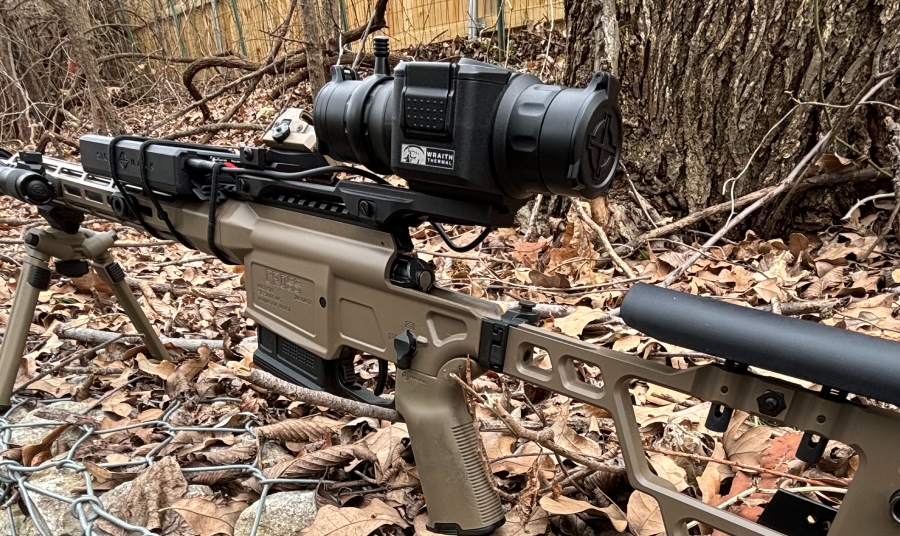(Photos by Jacky Rankin)
When it comes to hunting, having the right equipment can make all the difference. Digital riflescopes have revolutionized the hunting experience, and now that they’re more affordable than they have ever been, night hunting has increasingly become more popular. Night hunters can choose between two primary options: thermal vision and digital night vision. While both have their merits, thermal vision boasts several distinct advantages over digital night vision, making it an attractive choice for hunters. Let’s explore the advantages of both technologies and see which choice best fits your hunting scenarios.
Thermal

Thermal imaging devices have the ability to see heat, no matter if it's day or night. It works using something called "infrared thermography," which enables the devices to capture heat patterns. Thermal imagers can be built as monoculars, binoculars or riflescopes. These are used for a variety of applications such as hunting, security, wildlife observation, and camping.
Works in Any Lighting Condition
One of the most significant advantages of thermal vision is its ability to work in any lighting condition. These devices rely on a specialized sensor that detects heat radiation emitted by objects with temperatures above absolute zero. Consequently, thermal vision devices can be used in complete darkness, fog, smoke, and other adverse weather conditions. Night vision devices, conversely, depend on ambient light to amplify the existing illumination, making them less effective in low-light or no-light situations.
For hunters, this means that thermal vision can be relied upon regardless of the time of day or weather conditions. Hunters won't be limited by insufficient ambient light, ensuring that you can hunt safely and effectively in a broader range of scenarios.
Greater Detection Range
thermal vision devices offer a superior detection range when compared to digital night vision. This advantage stems from the fundamental difference in the detection mechanisms of the two technologies. Thermal vision devices detect thermal radiation, which can travel over long distances without significant attenuation, while IR light, which night vision relies on, is more susceptible to atmospheric absorption.
As a result, high-end thermal vision devices can detect human-sized targets at distances exceeding 1000 yards, while night vision devices might only manage to spot the same target at less than 500 yards. This greater detection range in thermal vision is a valuable asset for hunters seeking to spot game from a distance and plan their approach strategically.
Digital Night Vision

Digital night vision works when light entering the objective lens is converted into a digital signal via a CMOS sensor. The higher the resolution of the CMOS sensor, the clearer the image will be. Since night vision works by amplifying existing light, it doesn’t see well in absolute darkness. In cases like this, night vision can be augmented by invisible IR lights.
Better Target Identification
Digital night vision devices provide a more detailed and clearer image of targets than its thermal vision counterparts. Digital night vision often provides higher resolution and clearer images because it captures visible light, which contains more detail compared to the heat signatures detected by thermal cameras. The higher resolution allows for more detailed imagery, making it easier to discern objects and their features. Thermal imaging, while excellent for detecting temperature differences and seeing in complete darkness, typically has lower resolution compared to digital night vision. This lower resolution can result in less detailed images with fewer discernible features.
For hunters, this capability is particularly useful when targeting specific anatomical areas for a precise and ethical shot.
Color/Daytime Mode
The vast majority of thermal devices only display images in thermal mode. However, digital night vision riflescopes are frequently capable of displaying a full-color daytime mode in addition to nighttime mode, making them viable for use as a regular full-color digital optic. The ability to switch between daytime and nighttime modes makes digital night vision riflescopes versatile tools for various shooting conditions. Shooters can seamlessly transition between environments without needing to switch equipment, enhancing convenience and efficiency in the field.
Additionally, the inclusion of a full-color daytime mode simplifies zeroing procedures at shooting ranges. Unlike thermal scopes, which rely on heat-emitting targets for calibration, digital night vision riflescopes can be zeroed using conventional targets, making the sighting-in process easier.
This versatility and ease of use contribute to the growing popularity of digital night vision riflescopes among hunters, law enforcement professionals, and military personnel seeking reliable optics for both day and night operations.
The Sightmark Wraith Mini Thermal is a good example of a compact and affordable thermal imaging riflescope that is perfect for hunting in low-light and no-light conditions. It features a 384x288 thermal sensor with a detection range of up to 1400 yards and has a built-in video recorder so you can capture your hunts on video.
The Wraith Mini Thermal is a good value for the money and is a good option for hunters who are looking for an affordable and easy-to-use thermal imaging riflescope.
On the other hand, the Wraith 4K Mini represents the pinnacle of digital night vision technology, boasting a stunning 4K CMOS sensor and advanced features such as full-color HD imaging during the daytime and exceptional digital night vision capabilities. With its superior resolution, versatile recording options, and enhanced zoom capabilities, the Wraith 4K Mini is the ultimate choice for shooters who demand the highest level of performance and precision in a digital optic for both day and night use.
Ultimately, the choice between thermal vision and digital night vision will depend on your individual needs, preferences, and budget. Regardless of your decision, the adoption of digital vision technology can enhance your hunting experience, giving you a clearer edge in locating and tracking your prey.




3 comments
Love my new Wraith Mini Thermal , performs GREAT! My freezer is full of pork all year.
Have the Wraith mini 4K night vision scope. It has an incredible display at night and day and the 3 setting IR light that comes with it works great. Good digital scope especially for the price. I recommend it, it’s work the look!
My new Sight Mark is great see as clear as day glow.